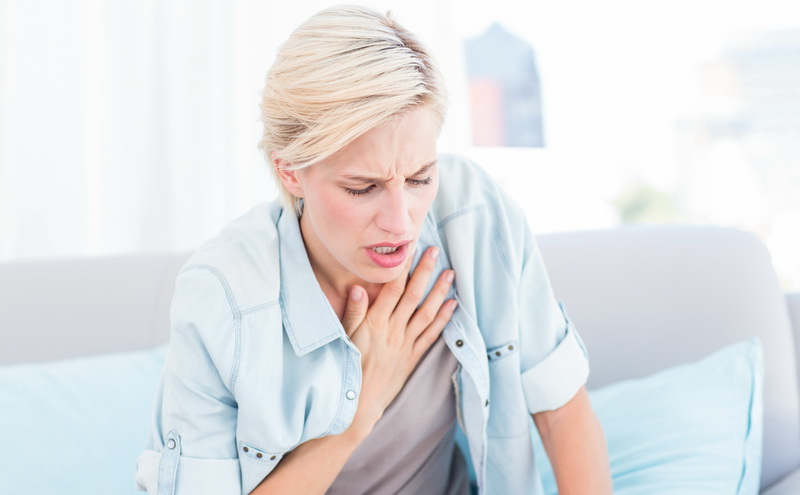8 Causes of Chest Pain That Aren’t a Heart Attack
October 18 2017
The mention of chest pain is often related to images of a heart attack, but there are plenty of other diseases and conditions that can trigger this symptom. These chest pain-causing conditions range from benign to dangerous.
Here are 8 conditions that can cause chest pain.
Heartburn
Gastroesophageal reflux occurs when a person’s stomach contents—including the gastric acids that help break down food—back up into the esophagus, the tube that connects the throat and stomach. Stomach acid is highly acidic, hence, the burning sensation behind your breastbone. Occasional reflux is fairly common and probably nothing to worry about, but if you’re experiencing it twice a week or more, you may have gastroesophageal reflux disease (GERD/GORD). Left untreated over time, GORD can cause asthma, chest congestion, and a condition called Barrett’s esophagus, which may increase your chances of developing a rare type of cancer.
Muscle strain
It’s possible for someone to mistake a strained chest muscle for something more serious, like a heart attack. A good rule of thumb is that if you can press on the wall of the chest and it feels even more painful, it’s more likely to be a musculoskeletal injury than a problem with your heart.
Costochondritis
An estimated 13% to 36% of adults who show up to the emergency room or their doctor’s office with acute chest pain are diagnosed with costochondritis, or inflammation where a rib bone meets up with the cartilage, Typically, people feel a type of pressure on their chest wall and—similar to a strained muscle—a tenderness when they press on the area.
If you do have costochondritis, the pain typically goes away in a few days or weeks; taking over-the-counter painkillers can help.
Shingles
The virus that causes chickenpox lingers in your body long after the spots have faded. In fact, varicella-zoster can reactivate in adulthood (usually in people older than 50) as a disease called shingles. The first symptoms include itching and burning skin. If the area over the chest is affected, someone might mistake this new pain for a heart attack or other cardiac issue. A few days later, however, the telltale rash can appear, followed by blisters.
If you think you have shingles, you should call your doctor ASAP. Antiviral medications can lessen the pain and shorten the duration of the symptoms, but only if you take them within 72 hours of the rash appearing. If it’s too late to take antivirals, your doctor can prescribe a prescription painkiller.
Pericarditis
If you’ve been battling a viral infection for the last few days, then suddenly wake up to a sharp, stabbing pain in your chest, you may have developed pericarditis, an inflammation in the layers of tissue that surround our heart.
Respiratory infections are often to blame, though other culprits include autoimmune disorders like lupus and rheumatoid arthritis. Although pericarditis is usually benign, it can really impact your quality of life.
Your doctor may diagnose your condition after ordering a CT scan, EKG, or chest x-ray. Chances are, however, your pericarditis will clear up in a few days or weeks simply by resting or taking over-the-counter pain medicine like ibuprofen, which also helps quell inflammation.
Pancreatitis
Just because a person’s chest pain is not heart attack-related doesn’t mean that it isn’t dangerous. One example is acute pancreatitis—the sudden inflammation of the pancreas, which is located just behind the stomach. Oftentimes, pancreatitis occurs when gallstones (usually made of hardened cholesterol) trigger inflammation in the pancreas—something that’s more likely to occur in women than men. If you think you have pancreatitis, you should get medical attention right away; you’ll probably have to stay in the hospital for a few days to get antibiotics, IV fluids, and pain medication. Your doctor will also want to do blood work and order other tests, like a CT scan or abdominal ultrasound.
Coronary artery disease
Coronary artery disease (CAD) is a type of heart disease caused by a buildup of plaque in the arteries that supply blood to the heart. Over time, cholesterol deposits lodge themselves in the walls of these arteries, which can block off blood flow and cause chest pain. While CAD can cause a sudden heart attack, it can also contribute to heart failure and arrhythmias. If you do receive a coronary artery disease diagnosis, your doctor may want to start you on statins, insert a stent into one of the arteries, or schedule you for bypass surgery.
Which brings us back to the number one rule cardiologists gave us: If you’re experiencing chest pain, it’s very important to get it checked out.
Panic attack
Having a panic attack can certainly feel like a heart attack; people often believe they’re dying when they are having one. In addition to chest pain, symptoms can include a pounding heart, sweating, shaking, nausea, dizziness, and a feeling of going crazy.
Panic attacks tend to crop up suddenly with no warning. You may be prone to them if you have a family member with a history of panic attacks, or if you’re dealing with major life changes and ongoing stress.
If you think you’ve experienced a panic attack, it’s smart to visit your primary care doctor. Your doc may refer you to a psychologist or psychiatrist.
If you’re having chest pain, and you’re not 100% sure what’s causing it, either call your doctor or 000 for emergencies.
Sourced from Health.com
